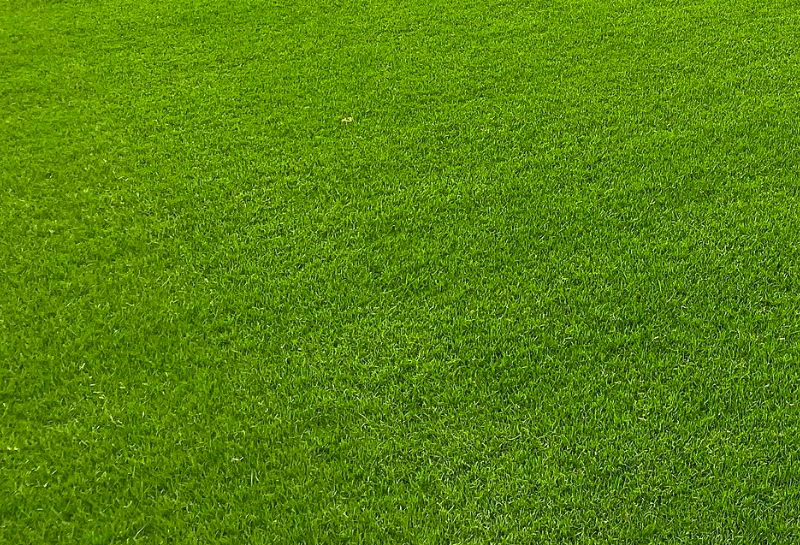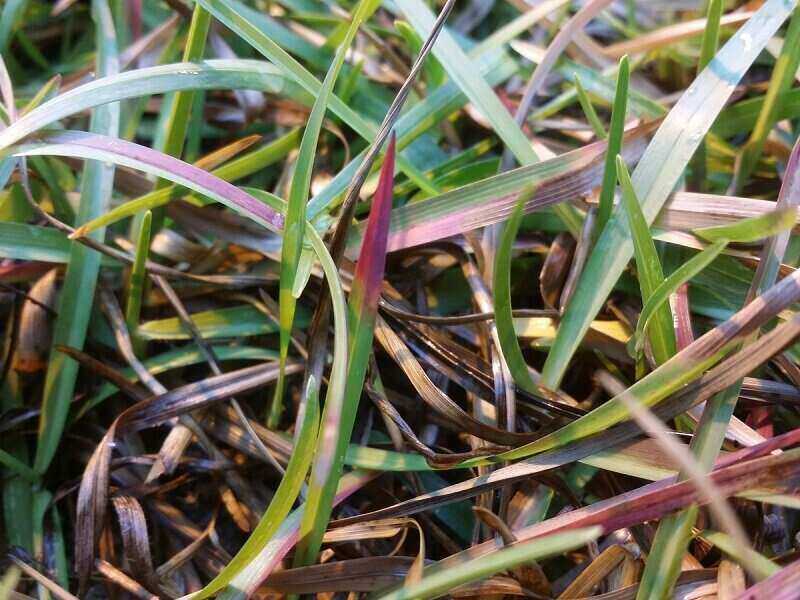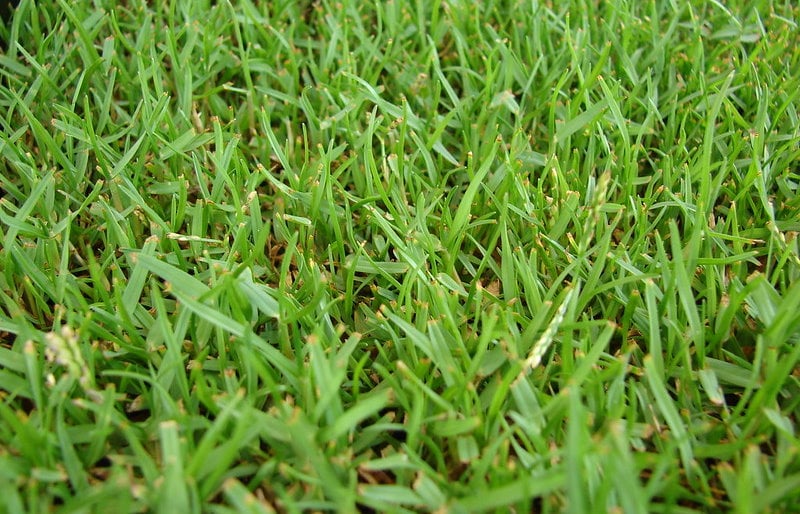
If you’re better at picking an NCAA bracket than a home turfgrass, keep reading. We’ve got five grass types that are a slam dunk for Durham lawns.

Gilba Solutions Pty Ltd | Wikimedia Commons | CC BY-SA 4.0
1. Bermudagrass
The first three grasses on our list are warm-season grasses. Warm-season grasses grow quickly during the warm summer months and go dormant (brown) from the first good frost until green-up in the spring.
Bermudagrass is a popular grass in the Durham-Chapel Hill region. Homeowners appreciate its green summer color and excellent traffic tolerance. Bermudagrass is fast to establish and prefers a low mowing height, so plan to mow often. Bermudagrass comes in common, improved common, and hybrid cultivars, so do your homework before you buy. You may want to talk to an expert to determine which cultivar is right for you.
- Classification: Warm-season grass
- Spreads by: Stolons and rhizomes
- Shade tolerance: Low; some cultivars may have slightly better shade tolerance, but in general, bermudagrass needs full sun
- Drought tolerance: High
- Foot traffic tolerance: Highly wear-resistant; if foot traffic damage does occur, bermudagrass recovers well because of its aggressive rhizomes.
- Maintenance needs: May need mowing as often as twice per week due to its low mowing height; plan to dethatch regularly
- Mowing height: 1-2 inches (rotary mower) or 0.75-1 inch (reel mower)
- Potential for disease: Low, but common diseases include spring dead spot, large patch, and take-all root rot
Other notes: Use a sharp mower blade for the best results. Fertilize at 4-4.5 pounds of nitrogen per 1,000 square feet per year for common bermudagrass varieties.
Grass Seed Options:
– Pennington Bermudagrass Bare Spot (5 lb. bag)
– Pennington Smart Seed Bermudagrass Mix (8.75-lb. bag)
– Scotts Turf Builder Bermudagrass (10-lb. bag)
– Hancock Seed Co. Bermudagrass (50-lb. bag)

Pxhere
2. Centipedegrass
Known as the “lazy man’s grass,” centipedegrass requires very little maintenance, which is a selling point for many homeowners. Centipedegrass works well in sandy, acidic soils and may be more common along coastal regions of North Carolina. Centipedegrass has a light green color and, like Zoysiagrass, is slow to establish. Consider sod or plugs for faster establishment.
This grass works best for lawns that get little or no foot traffic. So, if your lawn is something you like to look at from afar, this may be a good choice. Be sure to water this grass deeply when it shows signs of stress (wilting or off-colored turf). Its shallow roots can’t access water deep in the soil, so water management is important.
- Classification: Warm-season grass
- Spreads by: Stolons
- Shade tolerance: Full sun or partial shade
- Drought tolerance: Low to moderate
- Foot traffic tolerance: Very low
- Maintenance needs: Low, and requires less mowing than other grasses because of its slow growth habit
- Mowing height: 1.5-2 inches
- Potential for disease: Relatively low
Other notes: Plan to fertilize with 0.5-2 pounds of nitrogen per 1,000 square feet per year. Thatch will become problematic. Plan to dethatch every two or three years.
Grass Seed Options:
– Gulf Kist Coated Centipedegrass Seeds (1 lb.)
– Scotts EZ Seed Patch and Repair Centipedegrass (3.75 lbs.)
– TifBlair Centipedegrass (5-lb. bag)
– Pennington Centipedegrass and Mulch (5-lb. bag)

Forest and Kim Starr | Flickr | CC BY-SA 2.0
3. Zoysiagrass
Zoysiagrass is a hardy, low-maintenance warm-season grass that works well in some Durham lawns. Even though it is notoriously slow to establish, this grass has other characteristics that make it worthwhile. Zoysia has a low to medium mowing requirement, requires relatively little fertilizer, and has good wear tolerance. It also tolerates some shade.
Experts recommend starting Zoysiagrass from sod because starting from seed often has poor results due to its extremely slow rate to establish. This grass does very well in drought and has a medium to dark green color. It is a good choice for many low-maintenance home lawns.
- Classification: Warm-season grass
- Spreads by: Stolons and rhizomes
- Shade tolerance: Moderate
- Drought tolerance: High
- Foot traffic tolerance: Moderate to high
- Maintenance needs: Low to moderate
- Mowing height: 1-2.5 inches
- Potential for disease: Low to medium, depends on the cultivar
Other notes: Fertilize at 1-3 pounds of nitrogen per 1,000 square feet per year. Dethatch and/or aerate once thatch reaches 0.75 inch or greater, or use a thatch rake periodically to prevent high thatch levels. This grass may spread into your flower beds if you’re not careful (but it’s not as aggressive as bermudagrass). Use concrete or metal edging around flower beds (at least 2 inches deep) to prevent its rhizomes from tunneling their way in.
Grass Plug and Seed Options:
– Zoysia Plugs (50 Large Grass Plugs)
– Zoysia Plugs (50 Full & Lush Grass Plugs)
– Zoysia Plugs (100 Plugs)
– Zoysia Emerald Grass Seeds (1/8 lb. of seeds)
– Zenith Zenith Grass Seeds (1/8 lb. of seeds)

Brenda Ryan | Lawn Love
4. Kentucky bluegrass mix
Now that we’ve covered the warm-season grasses, we have two cool-season grasses to recommend. Before we dive in, remember that cool-season grasses have two periods of growth: one in the fall and one in the spring. They have a fairly good winter color but may go dormant in the summer when temperatures rise and water levels fall.
If you think a cool-season lawn is right for you, Kentucky bluegrass (KBG) mixes are a popular option in the North Carolina Piedmont region. If well managed, Kentucky bluegrass mixes produce a beautiful, classic-looking lawn, but these mixes require a moderate to high level of maintenance to get the healthy lawn you want. Most mixes in the North Carolina Piedmont include KBG and tall fescue or KBG, tall fescue, and fine fescue.
- Classification: Cool-season grass
- Spreads by: Kentucky bluegrass (rhizomes); fine fescues (bunch-type, except creeping red fescues, which have short rhizomes); tall fescues (most are bunch-type grasses)
- Shade tolerance: Moderate, depending on the mix. KBG needs full sun, but fine fescues and tall fescues can tolerate partial shade.
- Drought tolerance: Very good; may go dormant in summer droughts, but will recover quickly once cooler temperatures and rainfall resumes.
- Foot traffic tolerance: Very good overall; KBG and tall fescue resist traffic damage, but fine fescues work well in low-traffic areas.
- Maintenance needs: Moderate to high
- Mowing height: Depends on the mix — anywhere from 1.5-3.5 inches
- Potential for disease: Depends on the mix. Kentucky bluegrass has a moderate to high risk for disease, but proper management reduces this risk. Fine fescues and tall fescues are less prone to disease.
Other notes: Kentucky bluegrass recovers well from traffic stress because of its rhizomes, but the other cool-season species require overseeding to repair bare spots. Moderate to high mowing frequency. Needs 2-3.5 pounds of nitrogen fertilizer per 1,000 square feet per year. May develop thatch.
Grass Seed Options:
– Jonathan Green (11970) Blue Panther Kentucky Bluegrass Grass Seed (3 lbs.)
– SeedRanch Midnight Kentucky Bluegrass Seed (5 lbs.)
– Jacklin Seed – Biltmore Blue Blend – 100% Kentucky Bluegrass (5 lbs.)

Matt Lavin | Flickr | CC BY-SA 2.0
5. Tall fescue
Tall fescue is a popular cool-season grass that is prized for its year-round green color and relatively easy maintenance. You can start tall fescue from seed, which reduces your upfront costs and can use this grass in a full-sun or partial shade lawn.
Tall fescue has few disease problems and good drought tolerance. It tolerates a moderate level of traffic, but if your flag football games get to be too much for the lawn, plan to overseed in the fall. Tall fescue is a bunching grass and won’t fill in bare spots on its own.
- Classification: Cool-season grass
- Spreads by: Bunch-type grass — doesn’t spread well
- Shade tolerance: Full sun to partial shade
- Drought tolerance: Moderate to high
- Foot traffic tolerance: High, but if bare spots appear, you’ll need to reseed in the fall
- Maintenance needs: Relatively low, but requires frequent mowing
- Mowing height: 2.5-3.5
- Potential for disease: Low
Other notes: Needs 2-4 pounds of nitrogen per 1,000 square feet per year. The cultivar Kentucky-31 is not recommended for home lawns. Look for an “improved” variety (often called turf-type tall fescue) for better home lawn performance. Some experts recommend seeding a blend of two or three cultivars of tall fescue to provide better disease resistance and overall performance.
Grass Seed Options:
– Triple-Play Tall Fescue Grass Seed Blend (5000 sq ft)
– Eretz Kentucky 31 K31 Tall Fescue Grass Seed (choose your size)
– Pennington The Rebels Tall Fescue Grass Seed Mix (7 lb.)
How to select the best grass type for your Durham-Chapel Hill lawn
Each lawn is different, so consider these things before finalizing your grass type decision:
- What level of maintenance do you want to do (or pay someone else to do)?
- Bermudagrass and Kentucky bluegrass mixes will need more time and attention, while centipede and Zoysia require a little less. Tall fescue is relatively low maintenance but may require frequent mowing.
- How much sun or shade do you have on the lawn?
- Bermudagrass prefers full sun. The other grasses can tolerate partial shade.
- Does your lawn get a lot of foot traffic?
- Bermuda works well for high-traffic lawns and can self-repair if damage occurs. Tall fescue and Zoysia can handle high levels of traffic. (Caveat: Zoysia is slow to recover from wear, and tall fescue will need to be overseeded in the fall if the lawn is damaged.) Centipede prefers low or no traffic, and Kentucky bluegrass mixes handle traffic well but not as well as bermuda.
- Does your area suffer from drought?
- Centipede doesn’t do well in drought conditions. All of the other choices here tolerate drought well.
If you’re too busy cheering on the Blue Devils (ahem, or Tar Heels), contact one of our Durham lawn care pros today. With over 100,00 satisfied customers, our pros are sure to get your lawn ready for whatever madness the year may bring.
Main Photo Credit: Duke University campus | Warren LeMay from Cullowhee, NC | Wikimedia Commons | CC0
Lawn Love participates in the Amazon Services LLC Associates Program, an affiliate advertising program. Lawn Love may earn revenue from products promoted in this article.